The National Immunization Programme in Australia
VerifiedAdded on 2023/06/04
|13
|3540
|137
AI Summary
This report provides an overview of the National Immunization Programme (NIP) in Australia, its activities, resources, and ethical considerations. The NIP provides free vaccines to entitled adults, youths, children, and infants to prevent infections and serious results by optimizing immunization coverage in Australian citizens. The report highlights the ethical issues related to the operations of the NIP, including consent, autonomy, benefits, access/fairness, identification and management of risks, and quality and safety.
Contribute Materials
Your contribution can guide someone’s learning journey. Share your
documents today.
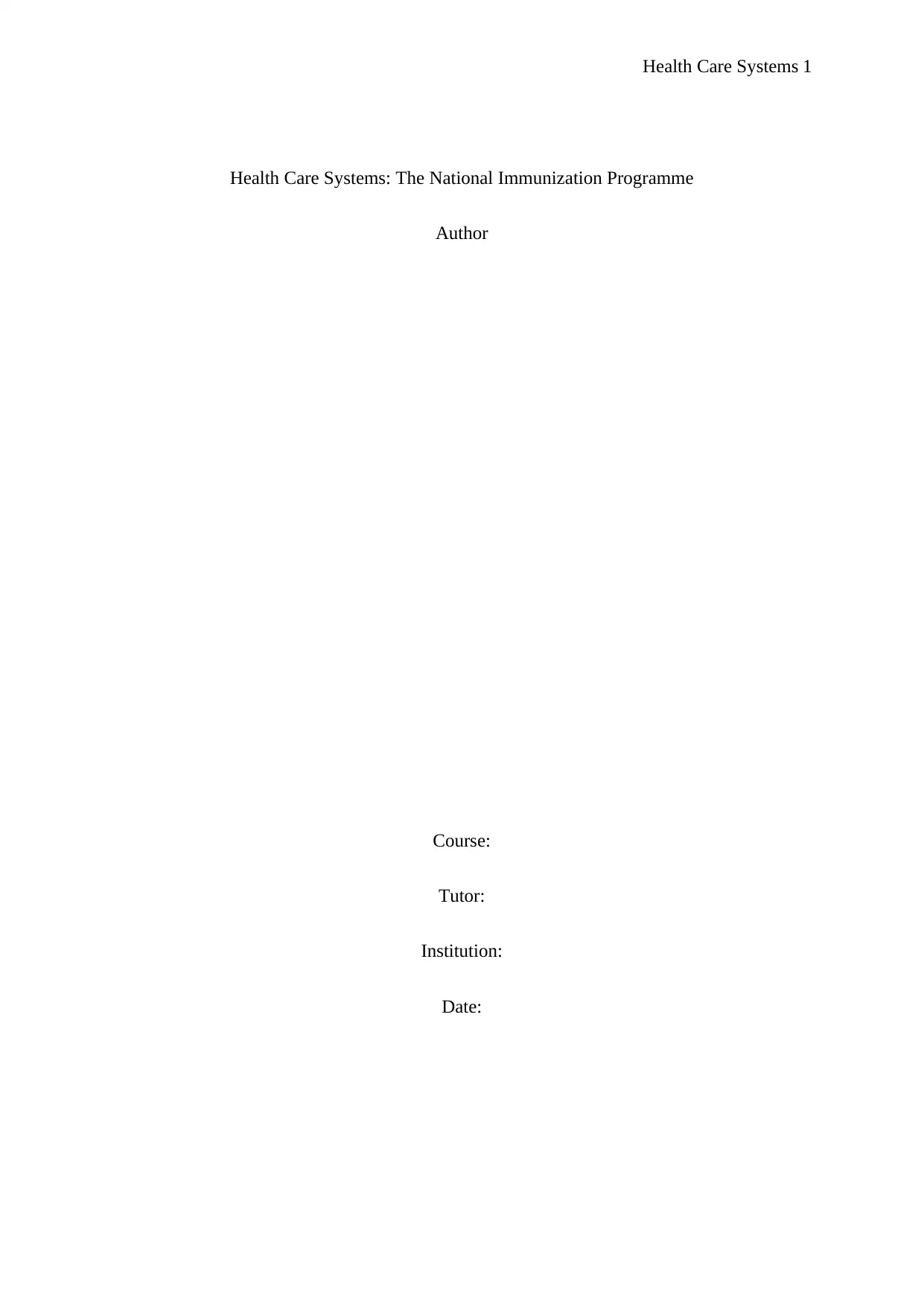
Health Care Systems 1
Health Care Systems: The National Immunization Programme
Author
Course:
Tutor:
Institution:
Date:
Health Care Systems: The National Immunization Programme
Author
Course:
Tutor:
Institution:
Date:
Secure Best Marks with AI Grader
Need help grading? Try our AI Grader for instant feedback on your assignments.
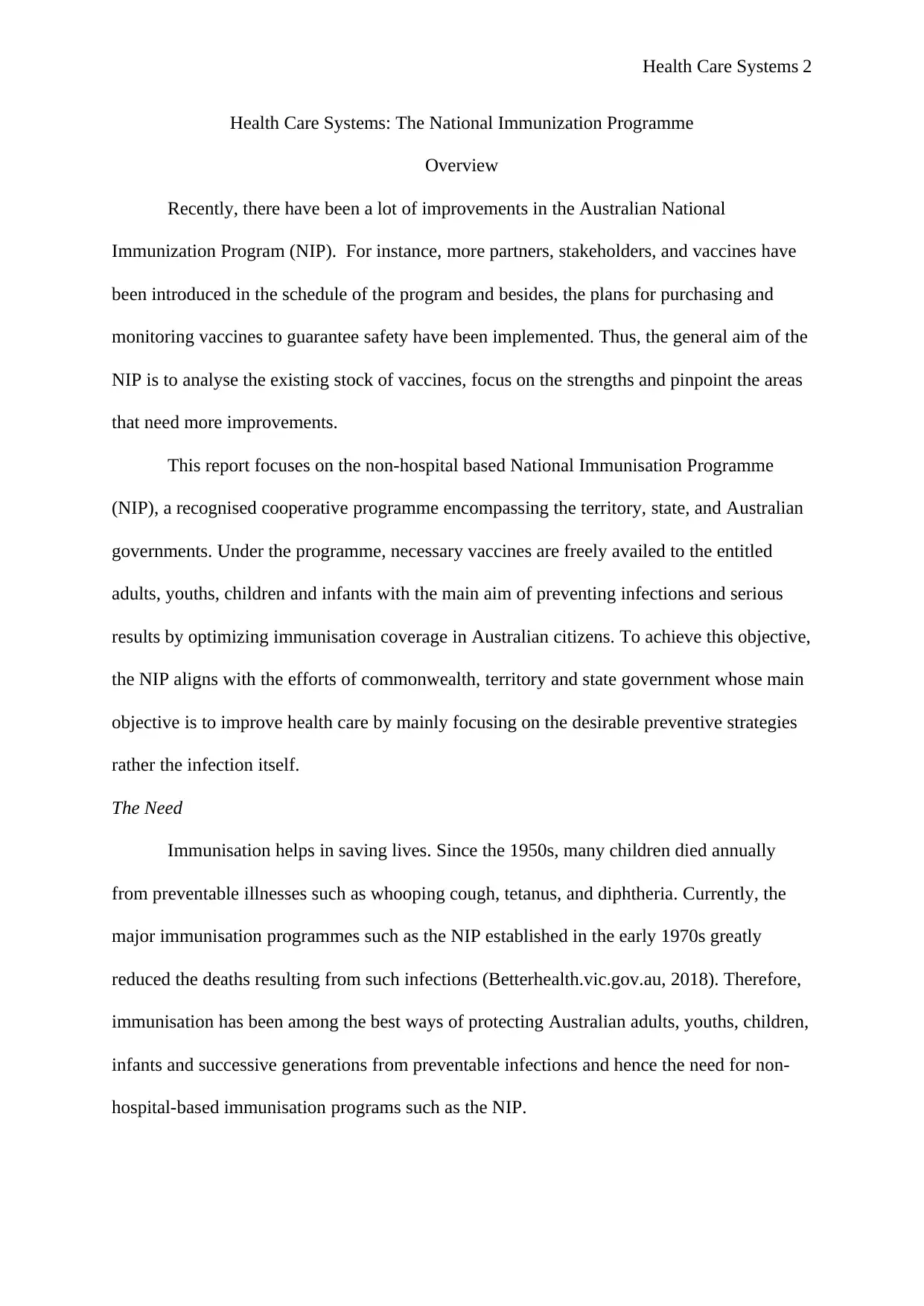
Health Care Systems 2
Health Care Systems: The National Immunization Programme
Overview
Recently, there have been a lot of improvements in the Australian National
Immunization Program (NIP). For instance, more partners, stakeholders, and vaccines have
been introduced in the schedule of the program and besides, the plans for purchasing and
monitoring vaccines to guarantee safety have been implemented. Thus, the general aim of the
NIP is to analyse the existing stock of vaccines, focus on the strengths and pinpoint the areas
that need more improvements.
This report focuses on the non-hospital based National Immunisation Programme
(NIP), a recognised cooperative programme encompassing the territory, state, and Australian
governments. Under the programme, necessary vaccines are freely availed to the entitled
adults, youths, children and infants with the main aim of preventing infections and serious
results by optimizing immunisation coverage in Australian citizens. To achieve this objective,
the NIP aligns with the efforts of commonwealth, territory and state government whose main
objective is to improve health care by mainly focusing on the desirable preventive strategies
rather the infection itself.
The Need
Immunisation helps in saving lives. Since the 1950s, many children died annually
from preventable illnesses such as whooping cough, tetanus, and diphtheria. Currently, the
major immunisation programmes such as the NIP established in the early 1970s greatly
reduced the deaths resulting from such infections (Betterhealth.vic.gov.au, 2018). Therefore,
immunisation has been among the best ways of protecting Australian adults, youths, children,
infants and successive generations from preventable infections and hence the need for non-
hospital-based immunisation programs such as the NIP.
Health Care Systems: The National Immunization Programme
Overview
Recently, there have been a lot of improvements in the Australian National
Immunization Program (NIP). For instance, more partners, stakeholders, and vaccines have
been introduced in the schedule of the program and besides, the plans for purchasing and
monitoring vaccines to guarantee safety have been implemented. Thus, the general aim of the
NIP is to analyse the existing stock of vaccines, focus on the strengths and pinpoint the areas
that need more improvements.
This report focuses on the non-hospital based National Immunisation Programme
(NIP), a recognised cooperative programme encompassing the territory, state, and Australian
governments. Under the programme, necessary vaccines are freely availed to the entitled
adults, youths, children and infants with the main aim of preventing infections and serious
results by optimizing immunisation coverage in Australian citizens. To achieve this objective,
the NIP aligns with the efforts of commonwealth, territory and state government whose main
objective is to improve health care by mainly focusing on the desirable preventive strategies
rather the infection itself.
The Need
Immunisation helps in saving lives. Since the 1950s, many children died annually
from preventable illnesses such as whooping cough, tetanus, and diphtheria. Currently, the
major immunisation programmes such as the NIP established in the early 1970s greatly
reduced the deaths resulting from such infections (Betterhealth.vic.gov.au, 2018). Therefore,
immunisation has been among the best ways of protecting Australian adults, youths, children,
infants and successive generations from preventable infections and hence the need for non-
hospital-based immunisation programs such as the NIP.
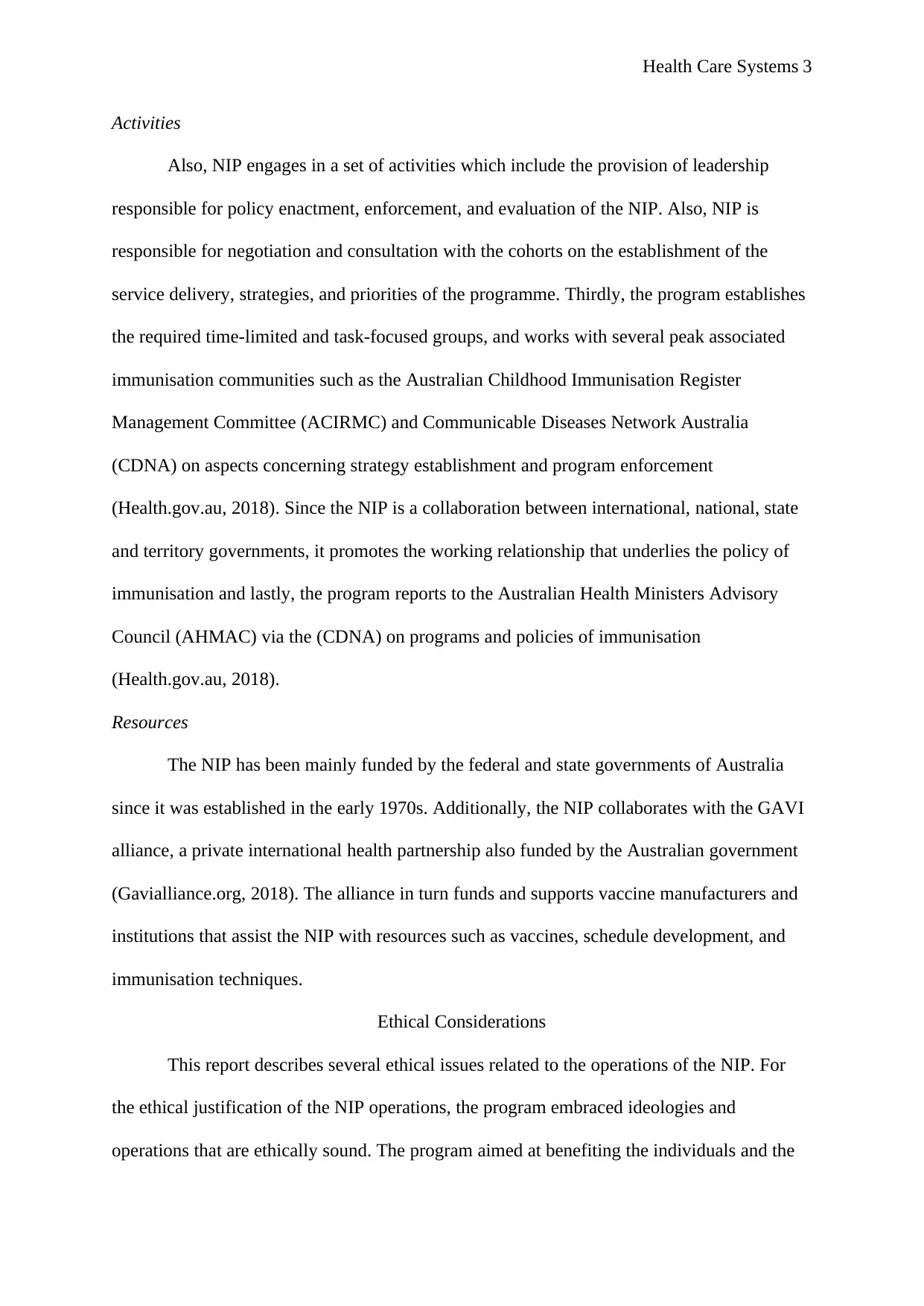
Health Care Systems 3
Activities
Also, NIP engages in a set of activities which include the provision of leadership
responsible for policy enactment, enforcement, and evaluation of the NIP. Also, NIP is
responsible for negotiation and consultation with the cohorts on the establishment of the
service delivery, strategies, and priorities of the programme. Thirdly, the program establishes
the required time-limited and task-focused groups, and works with several peak associated
immunisation communities such as the Australian Childhood Immunisation Register
Management Committee (ACIRMC) and Communicable Diseases Network Australia
(CDNA) on aspects concerning strategy establishment and program enforcement
(Health.gov.au, 2018). Since the NIP is a collaboration between international, national, state
and territory governments, it promotes the working relationship that underlies the policy of
immunisation and lastly, the program reports to the Australian Health Ministers Advisory
Council (AHMAC) via the (CDNA) on programs and policies of immunisation
(Health.gov.au, 2018).
Resources
The NIP has been mainly funded by the federal and state governments of Australia
since it was established in the early 1970s. Additionally, the NIP collaborates with the GAVI
alliance, a private international health partnership also funded by the Australian government
(Gavialliance.org, 2018). The alliance in turn funds and supports vaccine manufacturers and
institutions that assist the NIP with resources such as vaccines, schedule development, and
immunisation techniques.
Ethical Considerations
This report describes several ethical issues related to the operations of the NIP. For
the ethical justification of the NIP operations, the program embraced ideologies and
operations that are ethically sound. The program aimed at benefiting the individuals and the
Activities
Also, NIP engages in a set of activities which include the provision of leadership
responsible for policy enactment, enforcement, and evaluation of the NIP. Also, NIP is
responsible for negotiation and consultation with the cohorts on the establishment of the
service delivery, strategies, and priorities of the programme. Thirdly, the program establishes
the required time-limited and task-focused groups, and works with several peak associated
immunisation communities such as the Australian Childhood Immunisation Register
Management Committee (ACIRMC) and Communicable Diseases Network Australia
(CDNA) on aspects concerning strategy establishment and program enforcement
(Health.gov.au, 2018). Since the NIP is a collaboration between international, national, state
and territory governments, it promotes the working relationship that underlies the policy of
immunisation and lastly, the program reports to the Australian Health Ministers Advisory
Council (AHMAC) via the (CDNA) on programs and policies of immunisation
(Health.gov.au, 2018).
Resources
The NIP has been mainly funded by the federal and state governments of Australia
since it was established in the early 1970s. Additionally, the NIP collaborates with the GAVI
alliance, a private international health partnership also funded by the Australian government
(Gavialliance.org, 2018). The alliance in turn funds and supports vaccine manufacturers and
institutions that assist the NIP with resources such as vaccines, schedule development, and
immunisation techniques.
Ethical Considerations
This report describes several ethical issues related to the operations of the NIP. For
the ethical justification of the NIP operations, the program embraced ideologies and
operations that are ethically sound. The program aimed at benefiting the individuals and the
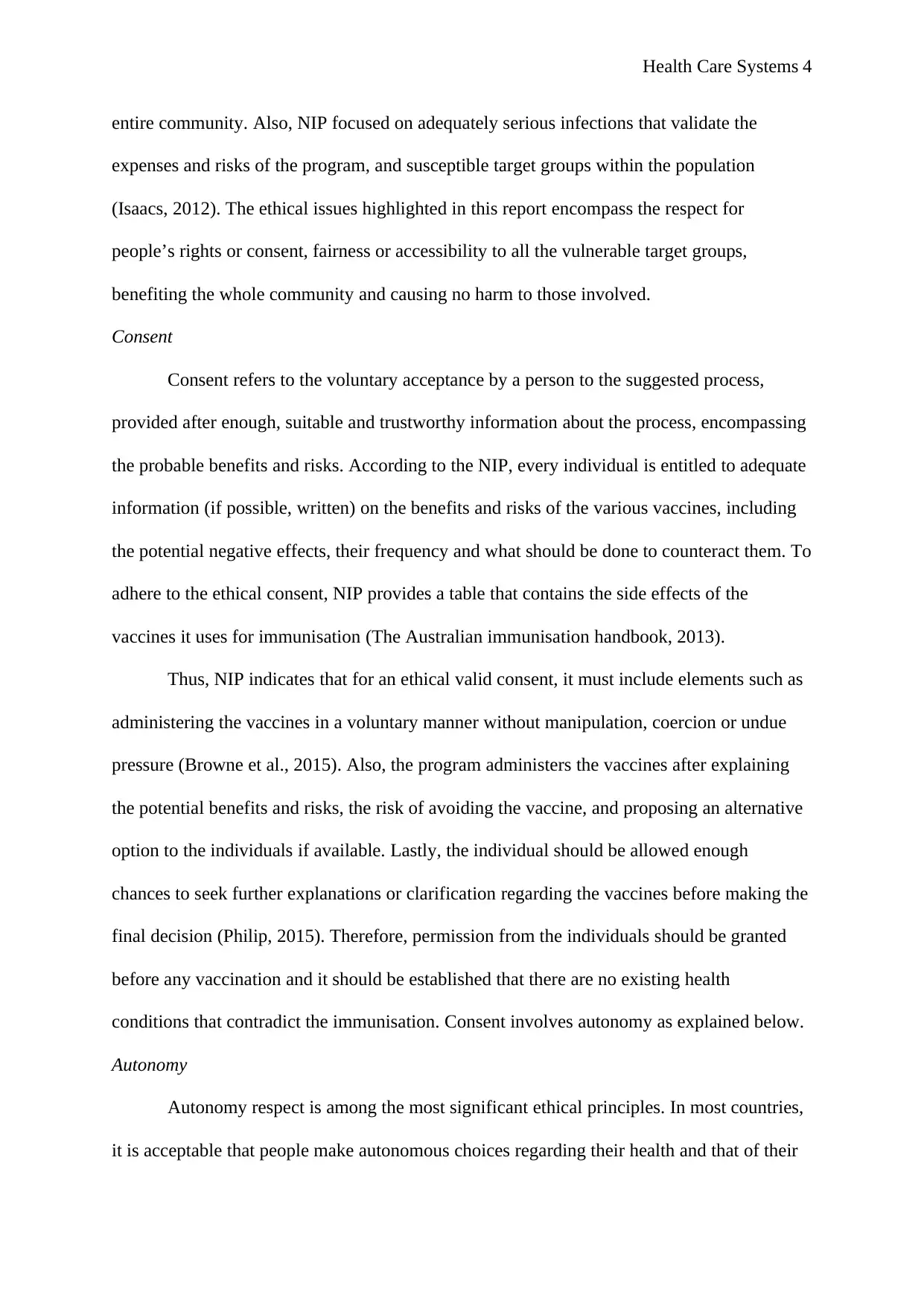
Health Care Systems 4
entire community. Also, NIP focused on adequately serious infections that validate the
expenses and risks of the program, and susceptible target groups within the population
(Isaacs, 2012). The ethical issues highlighted in this report encompass the respect for
people’s rights or consent, fairness or accessibility to all the vulnerable target groups,
benefiting the whole community and causing no harm to those involved.
Consent
Consent refers to the voluntary acceptance by a person to the suggested process,
provided after enough, suitable and trustworthy information about the process, encompassing
the probable benefits and risks. According to the NIP, every individual is entitled to adequate
information (if possible, written) on the benefits and risks of the various vaccines, including
the potential negative effects, their frequency and what should be done to counteract them. To
adhere to the ethical consent, NIP provides a table that contains the side effects of the
vaccines it uses for immunisation (The Australian immunisation handbook, 2013).
Thus, NIP indicates that for an ethical valid consent, it must include elements such as
administering the vaccines in a voluntary manner without manipulation, coercion or undue
pressure (Browne et al., 2015). Also, the program administers the vaccines after explaining
the potential benefits and risks, the risk of avoiding the vaccine, and proposing an alternative
option to the individuals if available. Lastly, the individual should be allowed enough
chances to seek further explanations or clarification regarding the vaccines before making the
final decision (Philip, 2015). Therefore, permission from the individuals should be granted
before any vaccination and it should be established that there are no existing health
conditions that contradict the immunisation. Consent involves autonomy as explained below.
Autonomy
Autonomy respect is among the most significant ethical principles. In most countries,
it is acceptable that people make autonomous choices regarding their health and that of their
entire community. Also, NIP focused on adequately serious infections that validate the
expenses and risks of the program, and susceptible target groups within the population
(Isaacs, 2012). The ethical issues highlighted in this report encompass the respect for
people’s rights or consent, fairness or accessibility to all the vulnerable target groups,
benefiting the whole community and causing no harm to those involved.
Consent
Consent refers to the voluntary acceptance by a person to the suggested process,
provided after enough, suitable and trustworthy information about the process, encompassing
the probable benefits and risks. According to the NIP, every individual is entitled to adequate
information (if possible, written) on the benefits and risks of the various vaccines, including
the potential negative effects, their frequency and what should be done to counteract them. To
adhere to the ethical consent, NIP provides a table that contains the side effects of the
vaccines it uses for immunisation (The Australian immunisation handbook, 2013).
Thus, NIP indicates that for an ethical valid consent, it must include elements such as
administering the vaccines in a voluntary manner without manipulation, coercion or undue
pressure (Browne et al., 2015). Also, the program administers the vaccines after explaining
the potential benefits and risks, the risk of avoiding the vaccine, and proposing an alternative
option to the individuals if available. Lastly, the individual should be allowed enough
chances to seek further explanations or clarification regarding the vaccines before making the
final decision (Philip, 2015). Therefore, permission from the individuals should be granted
before any vaccination and it should be established that there are no existing health
conditions that contradict the immunisation. Consent involves autonomy as explained below.
Autonomy
Autonomy respect is among the most significant ethical principles. In most countries,
it is acceptable that people make autonomous choices regarding their health and that of their
Secure Best Marks with AI Grader
Need help grading? Try our AI Grader for instant feedback on your assignments.
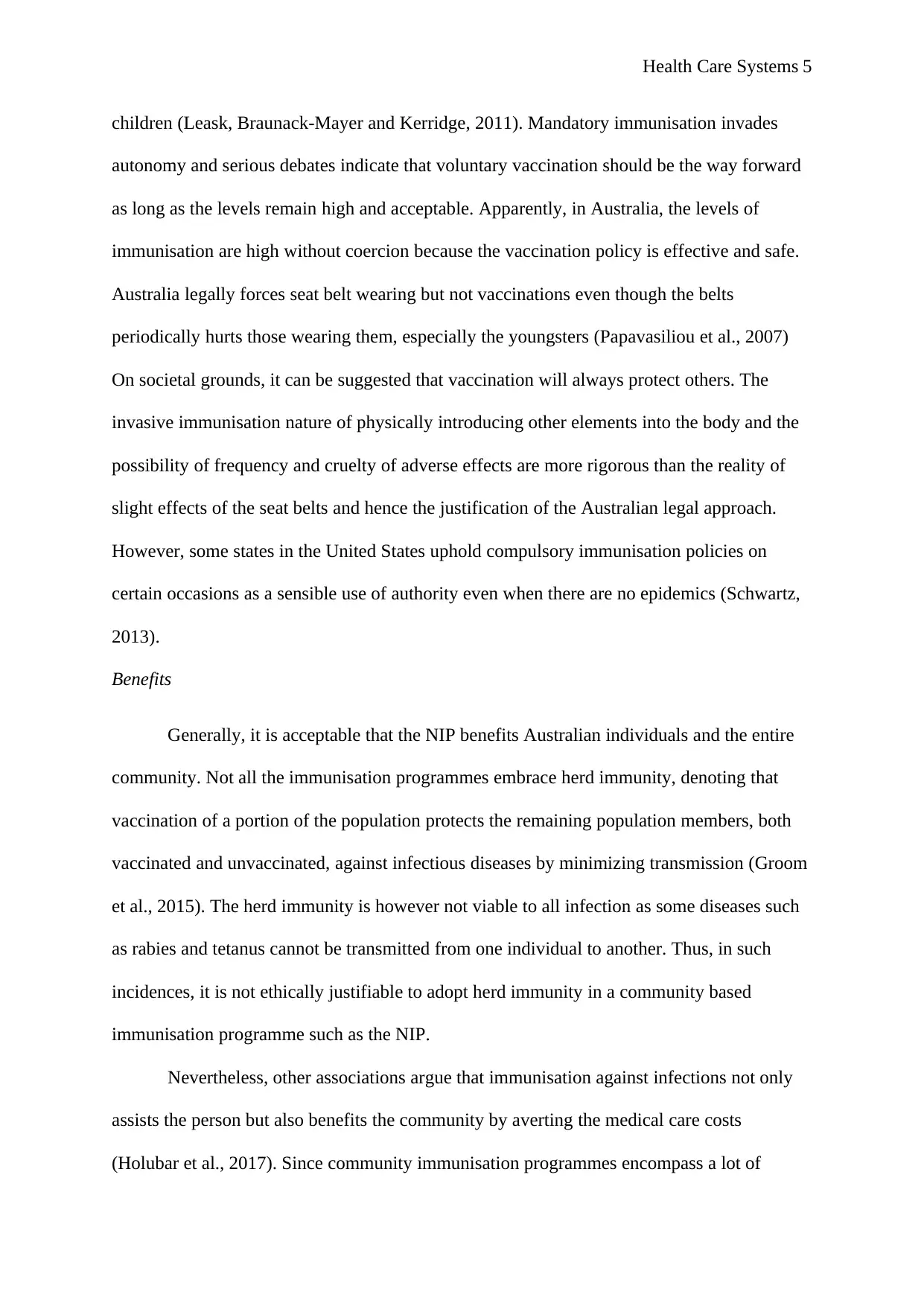
Health Care Systems 5
children (Leask, Braunack‐Mayer and Kerridge, 2011). Mandatory immunisation invades
autonomy and serious debates indicate that voluntary vaccination should be the way forward
as long as the levels remain high and acceptable. Apparently, in Australia, the levels of
immunisation are high without coercion because the vaccination policy is effective and safe.
Australia legally forces seat belt wearing but not vaccinations even though the belts
periodically hurts those wearing them, especially the youngsters (Papavasiliou et al., 2007)
On societal grounds, it can be suggested that vaccination will always protect others. The
invasive immunisation nature of physically introducing other elements into the body and the
possibility of frequency and cruelty of adverse effects are more rigorous than the reality of
slight effects of the seat belts and hence the justification of the Australian legal approach.
However, some states in the United States uphold compulsory immunisation policies on
certain occasions as a sensible use of authority even when there are no epidemics (Schwartz,
2013).
Benefits
Generally, it is acceptable that the NIP benefits Australian individuals and the entire
community. Not all the immunisation programmes embrace herd immunity, denoting that
vaccination of a portion of the population protects the remaining population members, both
vaccinated and unvaccinated, against infectious diseases by minimizing transmission (Groom
et al., 2015). The herd immunity is however not viable to all infection as some diseases such
as rabies and tetanus cannot be transmitted from one individual to another. Thus, in such
incidences, it is not ethically justifiable to adopt herd immunity in a community based
immunisation programme such as the NIP.
Nevertheless, other associations argue that immunisation against infections not only
assists the person but also benefits the community by averting the medical care costs
(Holubar et al., 2017). Since community immunisation programmes encompass a lot of
children (Leask, Braunack‐Mayer and Kerridge, 2011). Mandatory immunisation invades
autonomy and serious debates indicate that voluntary vaccination should be the way forward
as long as the levels remain high and acceptable. Apparently, in Australia, the levels of
immunisation are high without coercion because the vaccination policy is effective and safe.
Australia legally forces seat belt wearing but not vaccinations even though the belts
periodically hurts those wearing them, especially the youngsters (Papavasiliou et al., 2007)
On societal grounds, it can be suggested that vaccination will always protect others. The
invasive immunisation nature of physically introducing other elements into the body and the
possibility of frequency and cruelty of adverse effects are more rigorous than the reality of
slight effects of the seat belts and hence the justification of the Australian legal approach.
However, some states in the United States uphold compulsory immunisation policies on
certain occasions as a sensible use of authority even when there are no epidemics (Schwartz,
2013).
Benefits
Generally, it is acceptable that the NIP benefits Australian individuals and the entire
community. Not all the immunisation programmes embrace herd immunity, denoting that
vaccination of a portion of the population protects the remaining population members, both
vaccinated and unvaccinated, against infectious diseases by minimizing transmission (Groom
et al., 2015). The herd immunity is however not viable to all infection as some diseases such
as rabies and tetanus cannot be transmitted from one individual to another. Thus, in such
incidences, it is not ethically justifiable to adopt herd immunity in a community based
immunisation programme such as the NIP.
Nevertheless, other associations argue that immunisation against infections not only
assists the person but also benefits the community by averting the medical care costs
(Holubar et al., 2017). Since community immunisation programmes encompass a lot of
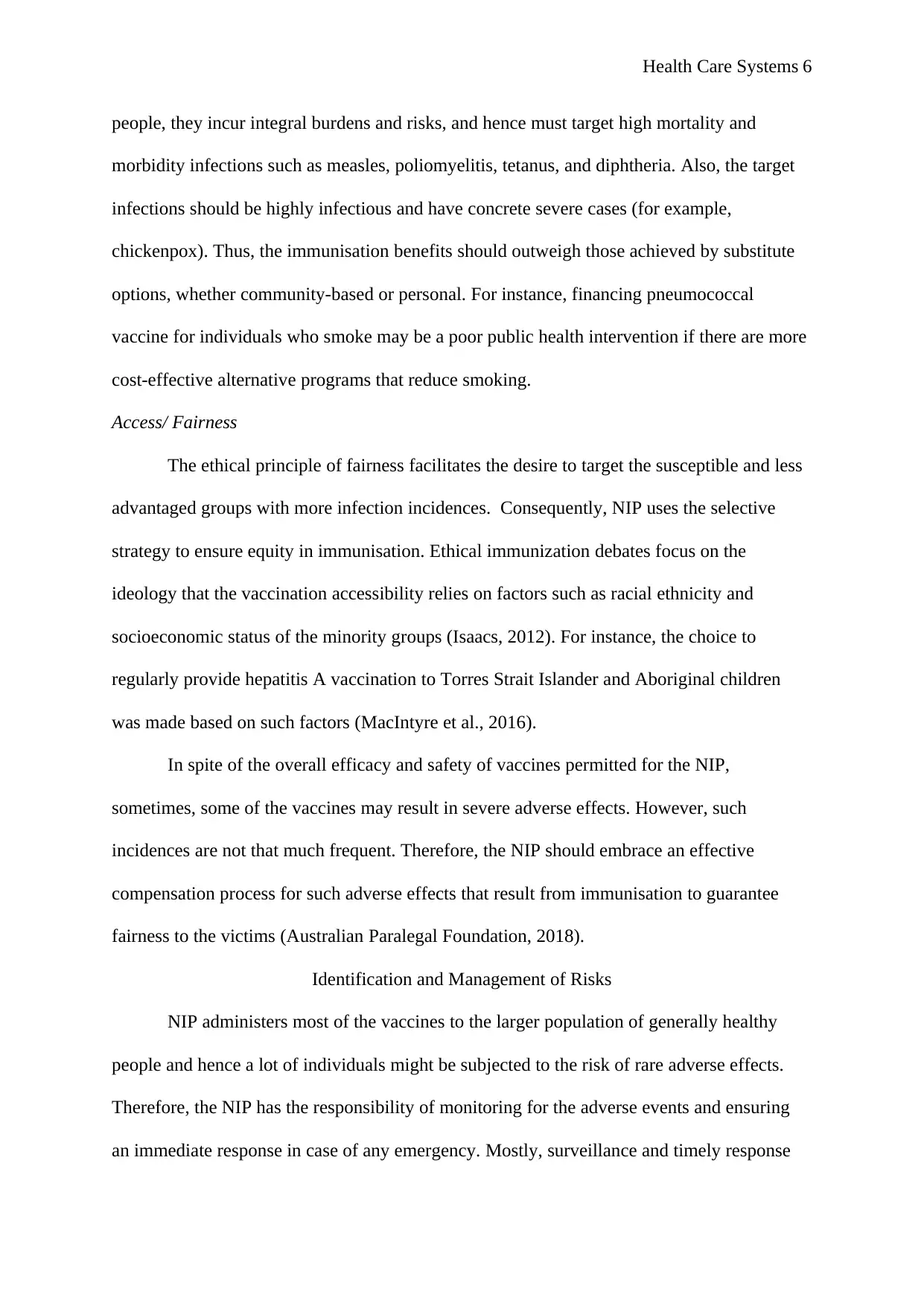
Health Care Systems 6
people, they incur integral burdens and risks, and hence must target high mortality and
morbidity infections such as measles, poliomyelitis, tetanus, and diphtheria. Also, the target
infections should be highly infectious and have concrete severe cases (for example,
chickenpox). Thus, the immunisation benefits should outweigh those achieved by substitute
options, whether community-based or personal. For instance, financing pneumococcal
vaccine for individuals who smoke may be a poor public health intervention if there are more
cost-effective alternative programs that reduce smoking.
Access/ Fairness
The ethical principle of fairness facilitates the desire to target the susceptible and less
advantaged groups with more infection incidences. Consequently, NIP uses the selective
strategy to ensure equity in immunisation. Ethical immunization debates focus on the
ideology that the vaccination accessibility relies on factors such as racial ethnicity and
socioeconomic status of the minority groups (Isaacs, 2012). For instance, the choice to
regularly provide hepatitis A vaccination to Torres Strait Islander and Aboriginal children
was made based on such factors (MacIntyre et al., 2016).
In spite of the overall efficacy and safety of vaccines permitted for the NIP,
sometimes, some of the vaccines may result in severe adverse effects. However, such
incidences are not that much frequent. Therefore, the NIP should embrace an effective
compensation process for such adverse effects that result from immunisation to guarantee
fairness to the victims (Australian Paralegal Foundation, 2018).
Identification and Management of Risks
NIP administers most of the vaccines to the larger population of generally healthy
people and hence a lot of individuals might be subjected to the risk of rare adverse effects.
Therefore, the NIP has the responsibility of monitoring for the adverse events and ensuring
an immediate response in case of any emergency. Mostly, surveillance and timely response
people, they incur integral burdens and risks, and hence must target high mortality and
morbidity infections such as measles, poliomyelitis, tetanus, and diphtheria. Also, the target
infections should be highly infectious and have concrete severe cases (for example,
chickenpox). Thus, the immunisation benefits should outweigh those achieved by substitute
options, whether community-based or personal. For instance, financing pneumococcal
vaccine for individuals who smoke may be a poor public health intervention if there are more
cost-effective alternative programs that reduce smoking.
Access/ Fairness
The ethical principle of fairness facilitates the desire to target the susceptible and less
advantaged groups with more infection incidences. Consequently, NIP uses the selective
strategy to ensure equity in immunisation. Ethical immunization debates focus on the
ideology that the vaccination accessibility relies on factors such as racial ethnicity and
socioeconomic status of the minority groups (Isaacs, 2012). For instance, the choice to
regularly provide hepatitis A vaccination to Torres Strait Islander and Aboriginal children
was made based on such factors (MacIntyre et al., 2016).
In spite of the overall efficacy and safety of vaccines permitted for the NIP,
sometimes, some of the vaccines may result in severe adverse effects. However, such
incidences are not that much frequent. Therefore, the NIP should embrace an effective
compensation process for such adverse effects that result from immunisation to guarantee
fairness to the victims (Australian Paralegal Foundation, 2018).
Identification and Management of Risks
NIP administers most of the vaccines to the larger population of generally healthy
people and hence a lot of individuals might be subjected to the risk of rare adverse effects.
Therefore, the NIP has the responsibility of monitoring for the adverse events and ensuring
an immediate response in case of any emergency. Mostly, surveillance and timely response
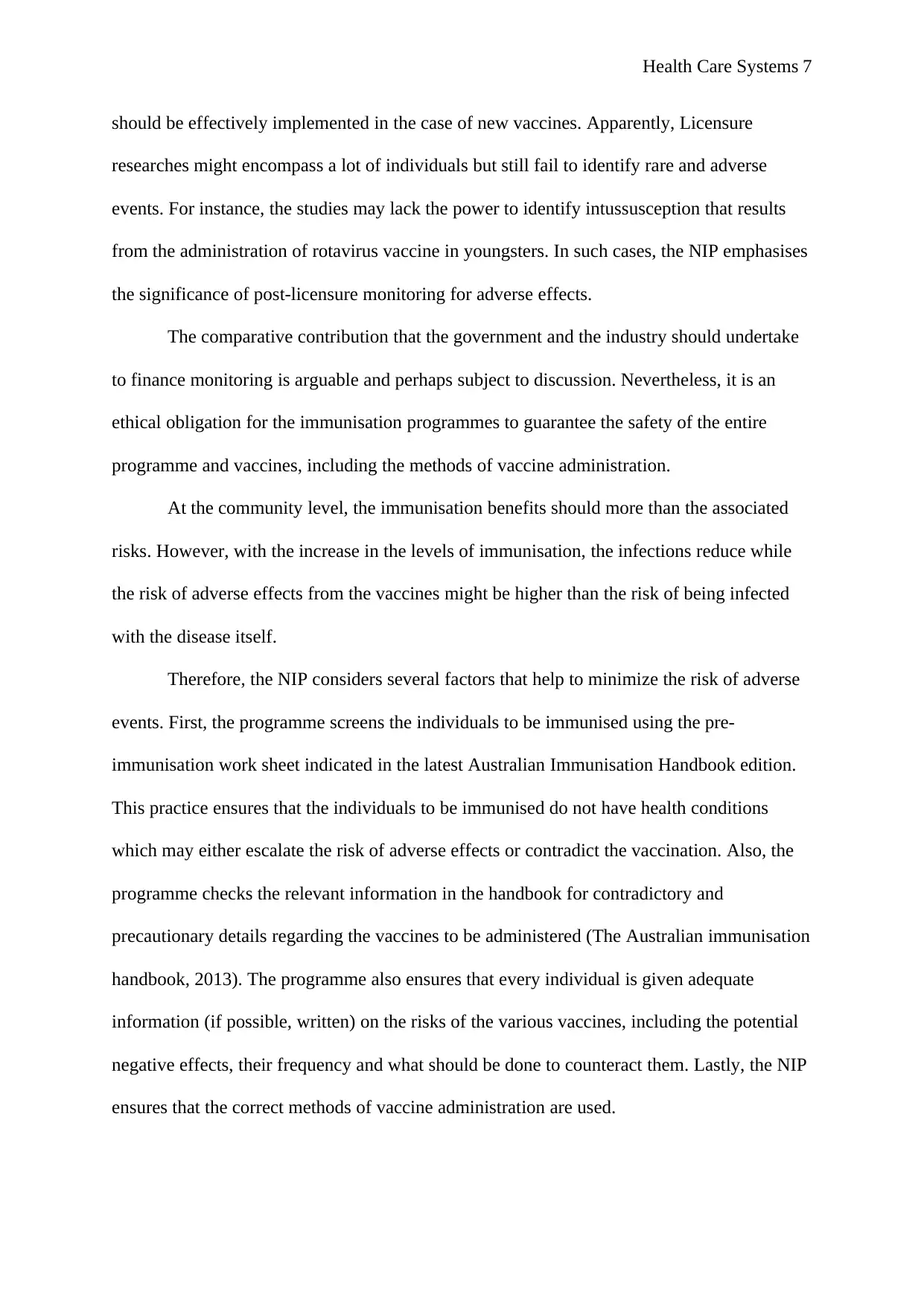
Health Care Systems 7
should be effectively implemented in the case of new vaccines. Apparently, Licensure
researches might encompass a lot of individuals but still fail to identify rare and adverse
events. For instance, the studies may lack the power to identify intussusception that results
from the administration of rotavirus vaccine in youngsters. In such cases, the NIP emphasises
the significance of post-licensure monitoring for adverse effects.
The comparative contribution that the government and the industry should undertake
to finance monitoring is arguable and perhaps subject to discussion. Nevertheless, it is an
ethical obligation for the immunisation programmes to guarantee the safety of the entire
programme and vaccines, including the methods of vaccine administration.
At the community level, the immunisation benefits should more than the associated
risks. However, with the increase in the levels of immunisation, the infections reduce while
the risk of adverse effects from the vaccines might be higher than the risk of being infected
with the disease itself.
Therefore, the NIP considers several factors that help to minimize the risk of adverse
events. First, the programme screens the individuals to be immunised using the pre-
immunisation work sheet indicated in the latest Australian Immunisation Handbook edition.
This practice ensures that the individuals to be immunised do not have health conditions
which may either escalate the risk of adverse effects or contradict the vaccination. Also, the
programme checks the relevant information in the handbook for contradictory and
precautionary details regarding the vaccines to be administered (The Australian immunisation
handbook, 2013). The programme also ensures that every individual is given adequate
information (if possible, written) on the risks of the various vaccines, including the potential
negative effects, their frequency and what should be done to counteract them. Lastly, the NIP
ensures that the correct methods of vaccine administration are used.
should be effectively implemented in the case of new vaccines. Apparently, Licensure
researches might encompass a lot of individuals but still fail to identify rare and adverse
events. For instance, the studies may lack the power to identify intussusception that results
from the administration of rotavirus vaccine in youngsters. In such cases, the NIP emphasises
the significance of post-licensure monitoring for adverse effects.
The comparative contribution that the government and the industry should undertake
to finance monitoring is arguable and perhaps subject to discussion. Nevertheless, it is an
ethical obligation for the immunisation programmes to guarantee the safety of the entire
programme and vaccines, including the methods of vaccine administration.
At the community level, the immunisation benefits should more than the associated
risks. However, with the increase in the levels of immunisation, the infections reduce while
the risk of adverse effects from the vaccines might be higher than the risk of being infected
with the disease itself.
Therefore, the NIP considers several factors that help to minimize the risk of adverse
events. First, the programme screens the individuals to be immunised using the pre-
immunisation work sheet indicated in the latest Australian Immunisation Handbook edition.
This practice ensures that the individuals to be immunised do not have health conditions
which may either escalate the risk of adverse effects or contradict the vaccination. Also, the
programme checks the relevant information in the handbook for contradictory and
precautionary details regarding the vaccines to be administered (The Australian immunisation
handbook, 2013). The programme also ensures that every individual is given adequate
information (if possible, written) on the risks of the various vaccines, including the potential
negative effects, their frequency and what should be done to counteract them. Lastly, the NIP
ensures that the correct methods of vaccine administration are used.
Paraphrase This Document
Need a fresh take? Get an instant paraphrase of this document with our AI Paraphraser
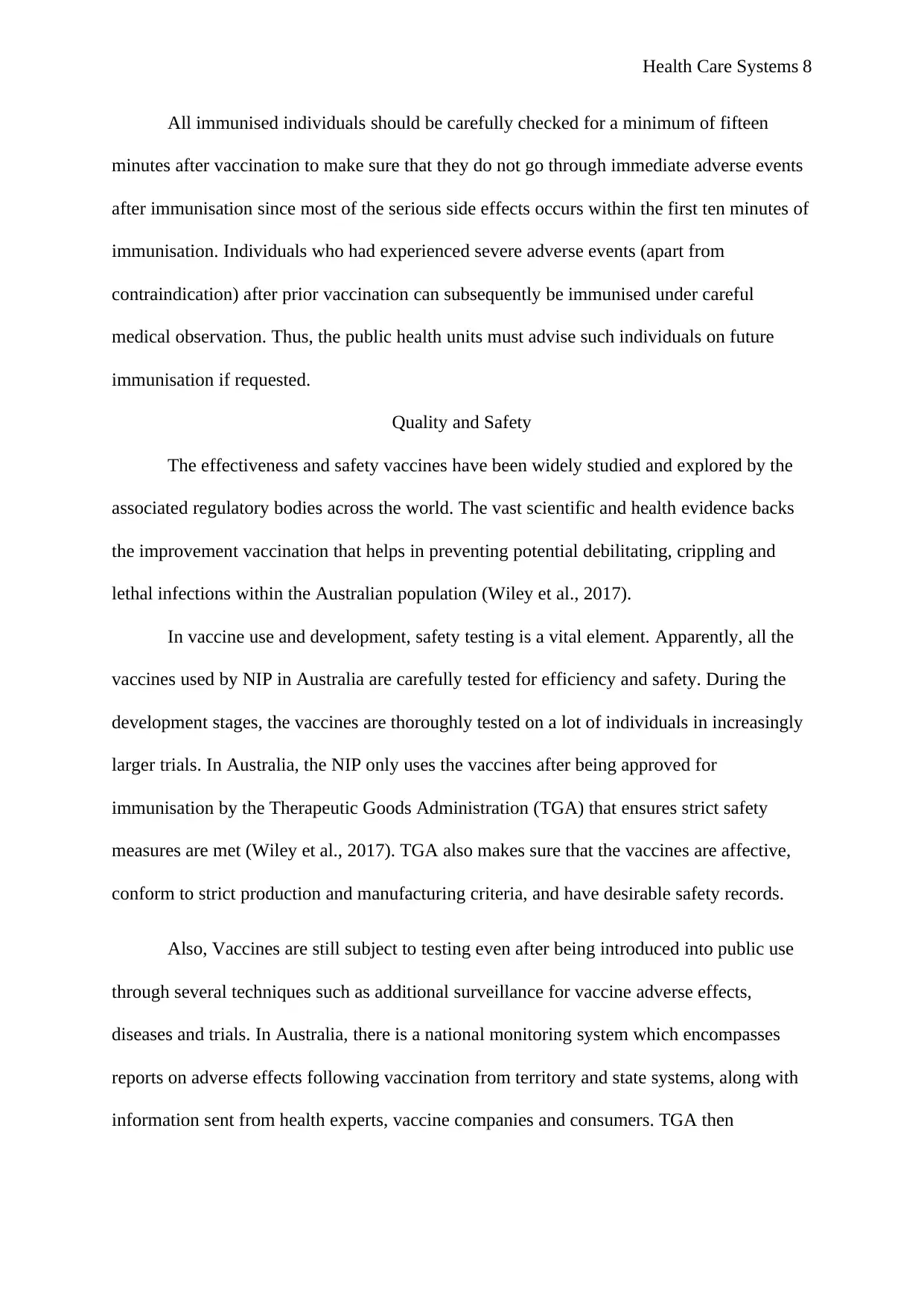
Health Care Systems 8
All immunised individuals should be carefully checked for a minimum of fifteen
minutes after vaccination to make sure that they do not go through immediate adverse events
after immunisation since most of the serious side effects occurs within the first ten minutes of
immunisation. Individuals who had experienced severe adverse events (apart from
contraindication) after prior vaccination can subsequently be immunised under careful
medical observation. Thus, the public health units must advise such individuals on future
immunisation if requested.
Quality and Safety
The effectiveness and safety vaccines have been widely studied and explored by the
associated regulatory bodies across the world. The vast scientific and health evidence backs
the improvement vaccination that helps in preventing potential debilitating, crippling and
lethal infections within the Australian population (Wiley et al., 2017).
In vaccine use and development, safety testing is a vital element. Apparently, all the
vaccines used by NIP in Australia are carefully tested for efficiency and safety. During the
development stages, the vaccines are thoroughly tested on a lot of individuals in increasingly
larger trials. In Australia, the NIP only uses the vaccines after being approved for
immunisation by the Therapeutic Goods Administration (TGA) that ensures strict safety
measures are met (Wiley et al., 2017). TGA also makes sure that the vaccines are affective,
conform to strict production and manufacturing criteria, and have desirable safety records.
Also, Vaccines are still subject to testing even after being introduced into public use
through several techniques such as additional surveillance for vaccine adverse effects,
diseases and trials. In Australia, there is a national monitoring system which encompasses
reports on adverse effects following vaccination from territory and state systems, along with
information sent from health experts, vaccine companies and consumers. TGA then
All immunised individuals should be carefully checked for a minimum of fifteen
minutes after vaccination to make sure that they do not go through immediate adverse events
after immunisation since most of the serious side effects occurs within the first ten minutes of
immunisation. Individuals who had experienced severe adverse events (apart from
contraindication) after prior vaccination can subsequently be immunised under careful
medical observation. Thus, the public health units must advise such individuals on future
immunisation if requested.
Quality and Safety
The effectiveness and safety vaccines have been widely studied and explored by the
associated regulatory bodies across the world. The vast scientific and health evidence backs
the improvement vaccination that helps in preventing potential debilitating, crippling and
lethal infections within the Australian population (Wiley et al., 2017).
In vaccine use and development, safety testing is a vital element. Apparently, all the
vaccines used by NIP in Australia are carefully tested for efficiency and safety. During the
development stages, the vaccines are thoroughly tested on a lot of individuals in increasingly
larger trials. In Australia, the NIP only uses the vaccines after being approved for
immunisation by the Therapeutic Goods Administration (TGA) that ensures strict safety
measures are met (Wiley et al., 2017). TGA also makes sure that the vaccines are affective,
conform to strict production and manufacturing criteria, and have desirable safety records.
Also, Vaccines are still subject to testing even after being introduced into public use
through several techniques such as additional surveillance for vaccine adverse effects,
diseases and trials. In Australia, there is a national monitoring system which encompasses
reports on adverse effects following vaccination from territory and state systems, along with
information sent from health experts, vaccine companies and consumers. TGA then
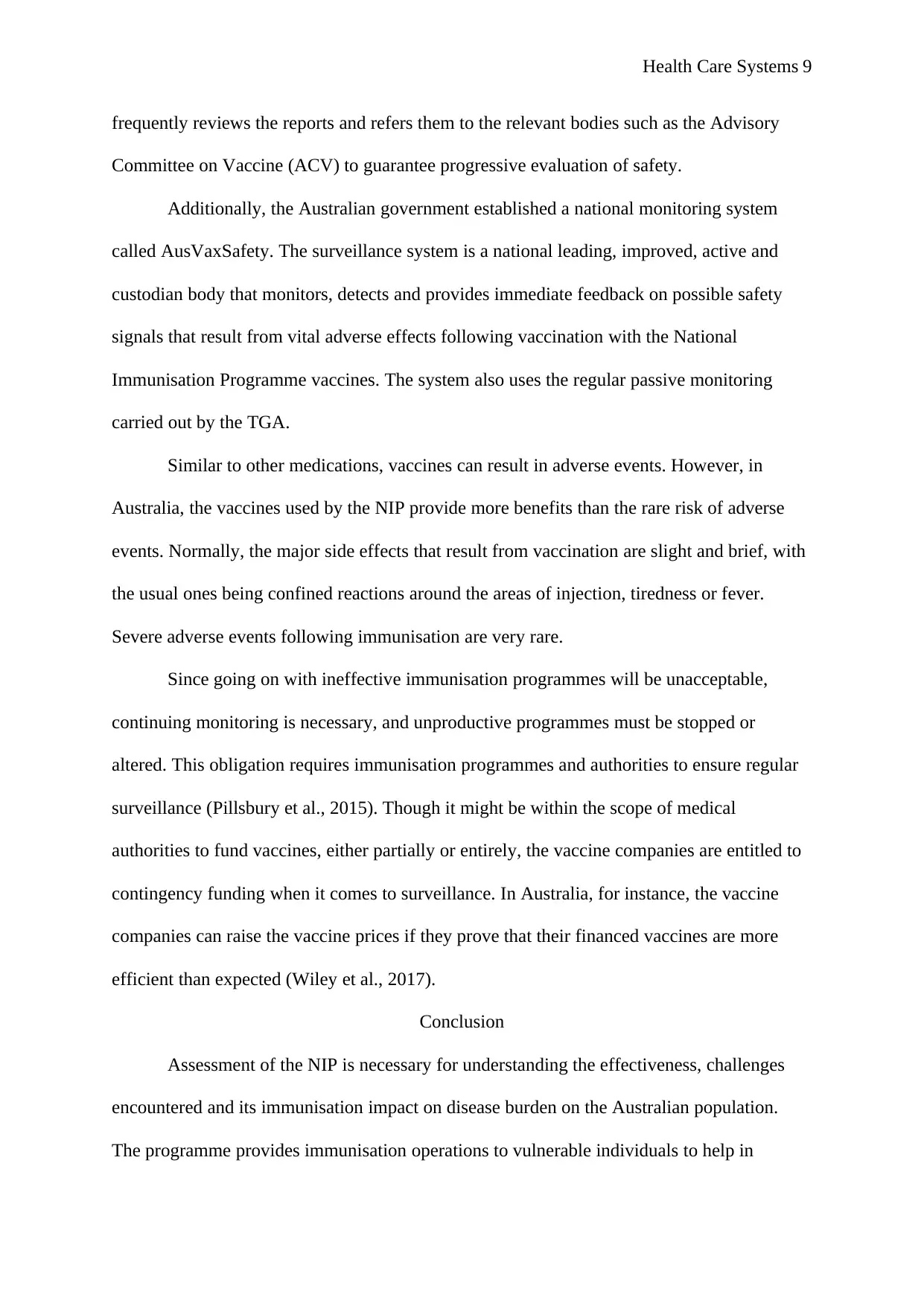
Health Care Systems 9
frequently reviews the reports and refers them to the relevant bodies such as the Advisory
Committee on Vaccine (ACV) to guarantee progressive evaluation of safety.
Additionally, the Australian government established a national monitoring system
called AusVaxSafety. The surveillance system is a national leading, improved, active and
custodian body that monitors, detects and provides immediate feedback on possible safety
signals that result from vital adverse effects following vaccination with the National
Immunisation Programme vaccines. The system also uses the regular passive monitoring
carried out by the TGA.
Similar to other medications, vaccines can result in adverse events. However, in
Australia, the vaccines used by the NIP provide more benefits than the rare risk of adverse
events. Normally, the major side effects that result from vaccination are slight and brief, with
the usual ones being confined reactions around the areas of injection, tiredness or fever.
Severe adverse events following immunisation are very rare.
Since going on with ineffective immunisation programmes will be unacceptable,
continuing monitoring is necessary, and unproductive programmes must be stopped or
altered. This obligation requires immunisation programmes and authorities to ensure regular
surveillance (Pillsbury et al., 2015). Though it might be within the scope of medical
authorities to fund vaccines, either partially or entirely, the vaccine companies are entitled to
contingency funding when it comes to surveillance. In Australia, for instance, the vaccine
companies can raise the vaccine prices if they prove that their financed vaccines are more
efficient than expected (Wiley et al., 2017).
Conclusion
Assessment of the NIP is necessary for understanding the effectiveness, challenges
encountered and its immunisation impact on disease burden on the Australian population.
The programme provides immunisation operations to vulnerable individuals to help in
frequently reviews the reports and refers them to the relevant bodies such as the Advisory
Committee on Vaccine (ACV) to guarantee progressive evaluation of safety.
Additionally, the Australian government established a national monitoring system
called AusVaxSafety. The surveillance system is a national leading, improved, active and
custodian body that monitors, detects and provides immediate feedback on possible safety
signals that result from vital adverse effects following vaccination with the National
Immunisation Programme vaccines. The system also uses the regular passive monitoring
carried out by the TGA.
Similar to other medications, vaccines can result in adverse events. However, in
Australia, the vaccines used by the NIP provide more benefits than the rare risk of adverse
events. Normally, the major side effects that result from vaccination are slight and brief, with
the usual ones being confined reactions around the areas of injection, tiredness or fever.
Severe adverse events following immunisation are very rare.
Since going on with ineffective immunisation programmes will be unacceptable,
continuing monitoring is necessary, and unproductive programmes must be stopped or
altered. This obligation requires immunisation programmes and authorities to ensure regular
surveillance (Pillsbury et al., 2015). Though it might be within the scope of medical
authorities to fund vaccines, either partially or entirely, the vaccine companies are entitled to
contingency funding when it comes to surveillance. In Australia, for instance, the vaccine
companies can raise the vaccine prices if they prove that their financed vaccines are more
efficient than expected (Wiley et al., 2017).
Conclusion
Assessment of the NIP is necessary for understanding the effectiveness, challenges
encountered and its immunisation impact on disease burden on the Australian population.
The programme provides immunisation operations to vulnerable individuals to help in
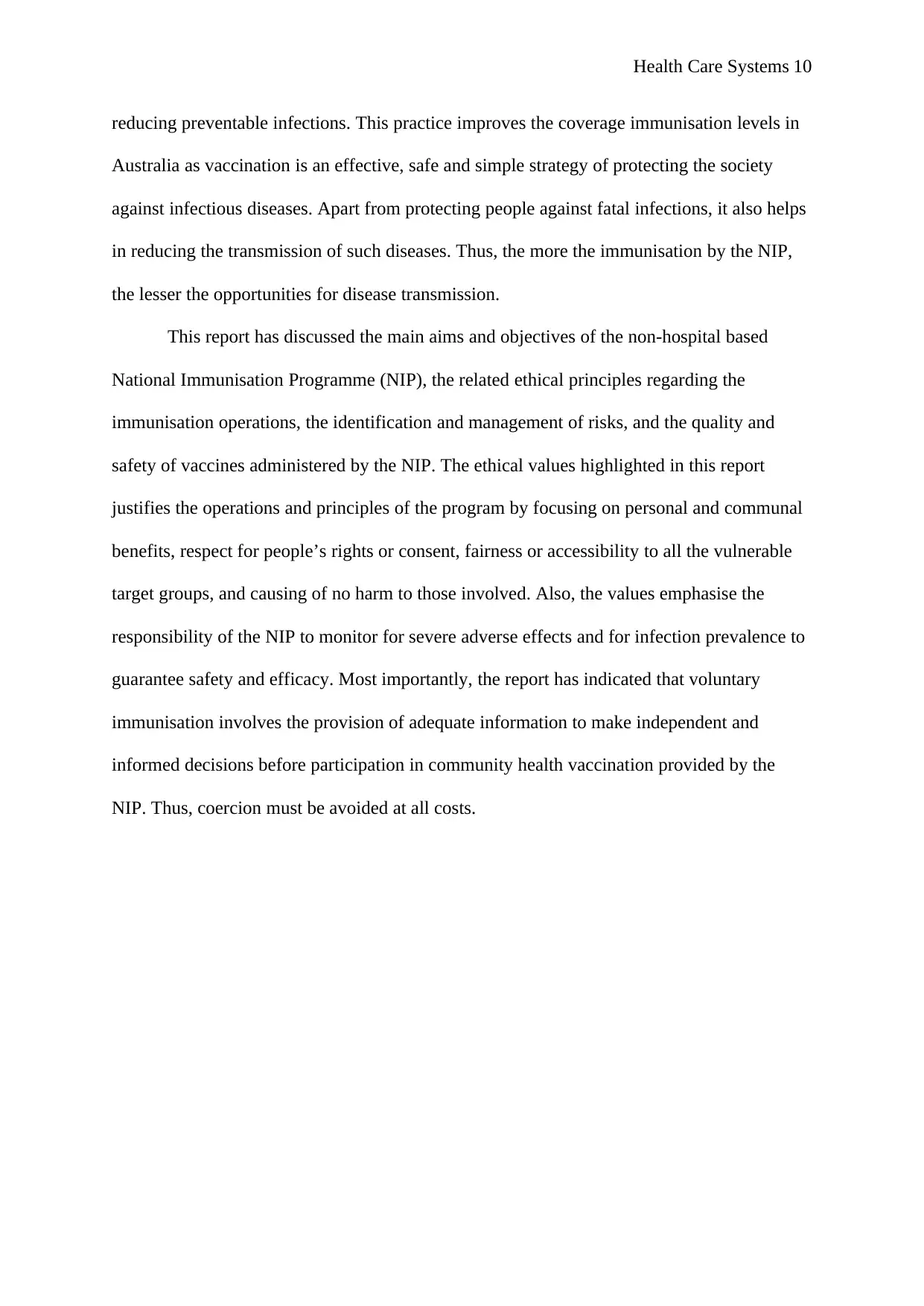
Health Care Systems 10
reducing preventable infections. This practice improves the coverage immunisation levels in
Australia as vaccination is an effective, safe and simple strategy of protecting the society
against infectious diseases. Apart from protecting people against fatal infections, it also helps
in reducing the transmission of such diseases. Thus, the more the immunisation by the NIP,
the lesser the opportunities for disease transmission.
This report has discussed the main aims and objectives of the non-hospital based
National Immunisation Programme (NIP), the related ethical principles regarding the
immunisation operations, the identification and management of risks, and the quality and
safety of vaccines administered by the NIP. The ethical values highlighted in this report
justifies the operations and principles of the program by focusing on personal and communal
benefits, respect for people’s rights or consent, fairness or accessibility to all the vulnerable
target groups, and causing of no harm to those involved. Also, the values emphasise the
responsibility of the NIP to monitor for severe adverse effects and for infection prevalence to
guarantee safety and efficacy. Most importantly, the report has indicated that voluntary
immunisation involves the provision of adequate information to make independent and
informed decisions before participation in community health vaccination provided by the
NIP. Thus, coercion must be avoided at all costs.
reducing preventable infections. This practice improves the coverage immunisation levels in
Australia as vaccination is an effective, safe and simple strategy of protecting the society
against infectious diseases. Apart from protecting people against fatal infections, it also helps
in reducing the transmission of such diseases. Thus, the more the immunisation by the NIP,
the lesser the opportunities for disease transmission.
This report has discussed the main aims and objectives of the non-hospital based
National Immunisation Programme (NIP), the related ethical principles regarding the
immunisation operations, the identification and management of risks, and the quality and
safety of vaccines administered by the NIP. The ethical values highlighted in this report
justifies the operations and principles of the program by focusing on personal and communal
benefits, respect for people’s rights or consent, fairness or accessibility to all the vulnerable
target groups, and causing of no harm to those involved. Also, the values emphasise the
responsibility of the NIP to monitor for severe adverse effects and for infection prevalence to
guarantee safety and efficacy. Most importantly, the report has indicated that voluntary
immunisation involves the provision of adequate information to make independent and
informed decisions before participation in community health vaccination provided by the
NIP. Thus, coercion must be avoided at all costs.
Secure Best Marks with AI Grader
Need help grading? Try our AI Grader for instant feedback on your assignments.

Health Care Systems 11
References
Australian Paralegal Foundation. 2018. Contemporary Challenges regarding Informed
Consent & Vaccination in Australia. [online] Available at:
http://para-legal.org.au/contemporary-challenges-regarding-informed-consent-
vaccination-in-australia/ [Accessed 29 Sep. 2018].
Betterhealth.vic.gov.au. 2018. Why immunisation is important. [online] Available at:
https://www.betterhealth.vic.gov.au/health/healthyliving/Why-immunisation-is-
important [Accessed 27 Sep. 2018].
Browne, M., Thomson, P., Rockloff, M.J. and Pennycook, G., 2015. Going against the herd:
psychological and cultural factors underlying the ‘vaccination confidence gap’. PLoS
One, 10(9), p.e0132562.
Gavialliance.org. 2018. Gavi Matching Fund partners are having a significant impact.
[online] Available at: https://www.gavi.org/funding/gavi-matching-fund/partners/
[Accessed 27 Sep. 2018].
Groom, H., Hopkins, D.P., Pabst, L.J., Morgan, J.M., Patel, M., Calonge, N., Coyle, R.,
Dombkowski, K., Groom, A.V., Kurilo, M.B. and Rasulnia, B., 2015. Immunization
information systems to increase vaccination rates: a community guide systematic
review. Journal of Public Health Management and Practice, 21(3), pp.227-248.
Health.gov.au. 2018. Department of Health | The National Immunisation Committee. [online]
Available at: http://www.health.gov.au/internet/main/publishing.nsf/content/cda-pubs-
cdi-2003-cdi2704-htm-cdi2704y.htm [Accessed 27 Sep. 2018].
References
Australian Paralegal Foundation. 2018. Contemporary Challenges regarding Informed
Consent & Vaccination in Australia. [online] Available at:
http://para-legal.org.au/contemporary-challenges-regarding-informed-consent-
vaccination-in-australia/ [Accessed 29 Sep. 2018].
Betterhealth.vic.gov.au. 2018. Why immunisation is important. [online] Available at:
https://www.betterhealth.vic.gov.au/health/healthyliving/Why-immunisation-is-
important [Accessed 27 Sep. 2018].
Browne, M., Thomson, P., Rockloff, M.J. and Pennycook, G., 2015. Going against the herd:
psychological and cultural factors underlying the ‘vaccination confidence gap’. PLoS
One, 10(9), p.e0132562.
Gavialliance.org. 2018. Gavi Matching Fund partners are having a significant impact.
[online] Available at: https://www.gavi.org/funding/gavi-matching-fund/partners/
[Accessed 27 Sep. 2018].
Groom, H., Hopkins, D.P., Pabst, L.J., Morgan, J.M., Patel, M., Calonge, N., Coyle, R.,
Dombkowski, K., Groom, A.V., Kurilo, M.B. and Rasulnia, B., 2015. Immunization
information systems to increase vaccination rates: a community guide systematic
review. Journal of Public Health Management and Practice, 21(3), pp.227-248.
Health.gov.au. 2018. Department of Health | The National Immunisation Committee. [online]
Available at: http://www.health.gov.au/internet/main/publishing.nsf/content/cda-pubs-
cdi-2003-cdi2704-htm-cdi2704y.htm [Accessed 27 Sep. 2018].
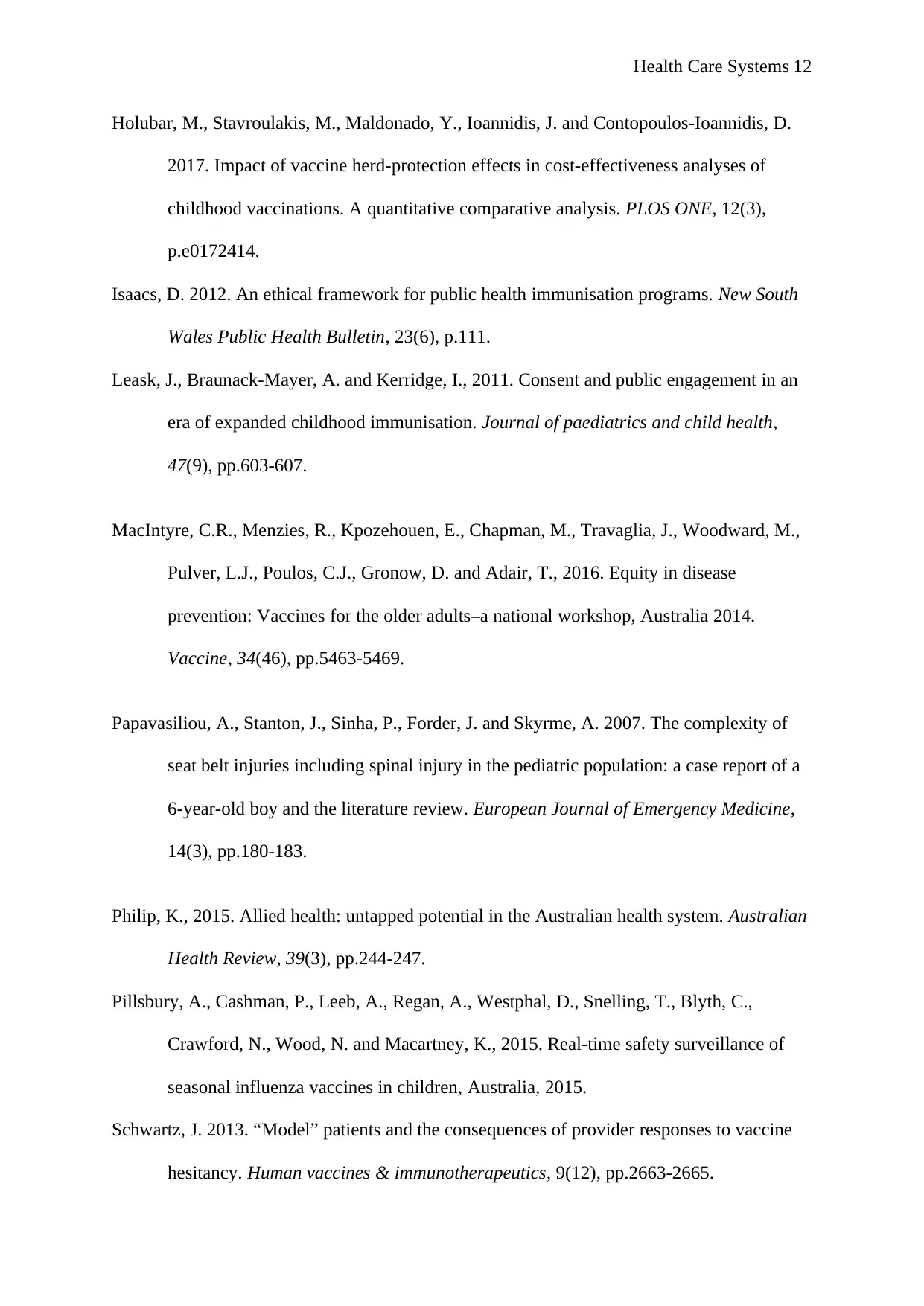
Health Care Systems 12
Holubar, M., Stavroulakis, M., Maldonado, Y., Ioannidis, J. and Contopoulos-Ioannidis, D.
2017. Impact of vaccine herd-protection effects in cost-effectiveness analyses of
childhood vaccinations. A quantitative comparative analysis. PLOS ONE, 12(3),
p.e0172414.
Isaacs, D. 2012. An ethical framework for public health immunisation programs. New South
Wales Public Health Bulletin, 23(6), p.111.
Leask, J., Braunack‐Mayer, A. and Kerridge, I., 2011. Consent and public engagement in an
era of expanded childhood immunisation. Journal of paediatrics and child health,
47(9), pp.603-607.
MacIntyre, C.R., Menzies, R., Kpozehouen, E., Chapman, M., Travaglia, J., Woodward, M.,
Pulver, L.J., Poulos, C.J., Gronow, D. and Adair, T., 2016. Equity in disease
prevention: Vaccines for the older adults–a national workshop, Australia 2014.
Vaccine, 34(46), pp.5463-5469.
Papavasiliou, A., Stanton, J., Sinha, P., Forder, J. and Skyrme, A. 2007. The complexity of
seat belt injuries including spinal injury in the pediatric population: a case report of a
6-year-old boy and the literature review. European Journal of Emergency Medicine,
14(3), pp.180-183.
Philip, K., 2015. Allied health: untapped potential in the Australian health system. Australian
Health Review, 39(3), pp.244-247.
Pillsbury, A., Cashman, P., Leeb, A., Regan, A., Westphal, D., Snelling, T., Blyth, C.,
Crawford, N., Wood, N. and Macartney, K., 2015. Real-time safety surveillance of
seasonal influenza vaccines in children, Australia, 2015.
Schwartz, J. 2013. “Model” patients and the consequences of provider responses to vaccine
hesitancy. Human vaccines & immunotherapeutics, 9(12), pp.2663-2665.
Holubar, M., Stavroulakis, M., Maldonado, Y., Ioannidis, J. and Contopoulos-Ioannidis, D.
2017. Impact of vaccine herd-protection effects in cost-effectiveness analyses of
childhood vaccinations. A quantitative comparative analysis. PLOS ONE, 12(3),
p.e0172414.
Isaacs, D. 2012. An ethical framework for public health immunisation programs. New South
Wales Public Health Bulletin, 23(6), p.111.
Leask, J., Braunack‐Mayer, A. and Kerridge, I., 2011. Consent and public engagement in an
era of expanded childhood immunisation. Journal of paediatrics and child health,
47(9), pp.603-607.
MacIntyre, C.R., Menzies, R., Kpozehouen, E., Chapman, M., Travaglia, J., Woodward, M.,
Pulver, L.J., Poulos, C.J., Gronow, D. and Adair, T., 2016. Equity in disease
prevention: Vaccines for the older adults–a national workshop, Australia 2014.
Vaccine, 34(46), pp.5463-5469.
Papavasiliou, A., Stanton, J., Sinha, P., Forder, J. and Skyrme, A. 2007. The complexity of
seat belt injuries including spinal injury in the pediatric population: a case report of a
6-year-old boy and the literature review. European Journal of Emergency Medicine,
14(3), pp.180-183.
Philip, K., 2015. Allied health: untapped potential in the Australian health system. Australian
Health Review, 39(3), pp.244-247.
Pillsbury, A., Cashman, P., Leeb, A., Regan, A., Westphal, D., Snelling, T., Blyth, C.,
Crawford, N., Wood, N. and Macartney, K., 2015. Real-time safety surveillance of
seasonal influenza vaccines in children, Australia, 2015.
Schwartz, J. 2013. “Model” patients and the consequences of provider responses to vaccine
hesitancy. Human vaccines & immunotherapeutics, 9(12), pp.2663-2665.
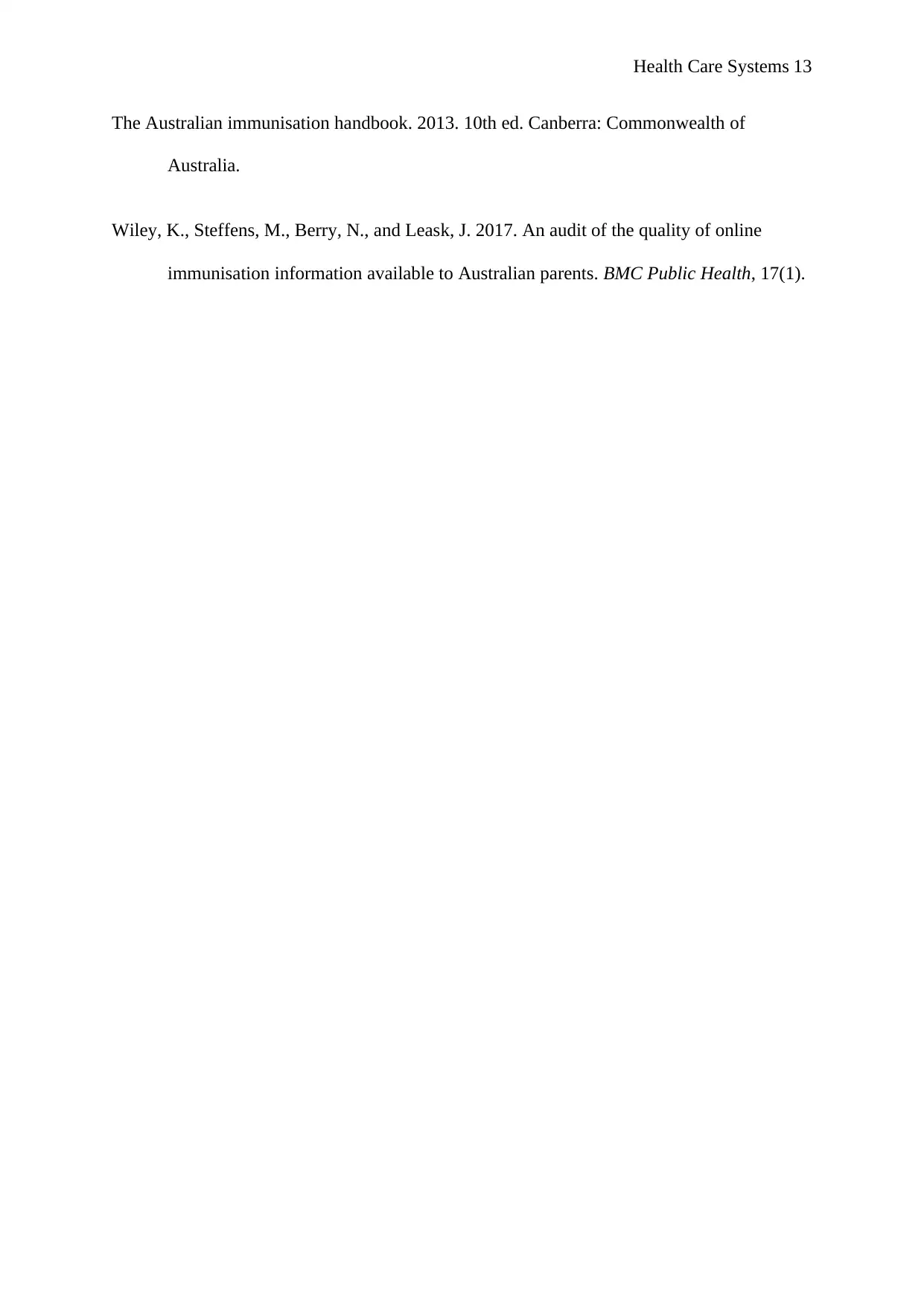
Health Care Systems 13
The Australian immunisation handbook. 2013. 10th ed. Canberra: Commonwealth of
Australia.
Wiley, K., Steffens, M., Berry, N., and Leask, J. 2017. An audit of the quality of online
immunisation information available to Australian parents. BMC Public Health, 17(1).
The Australian immunisation handbook. 2013. 10th ed. Canberra: Commonwealth of
Australia.
Wiley, K., Steffens, M., Berry, N., and Leask, J. 2017. An audit of the quality of online
immunisation information available to Australian parents. BMC Public Health, 17(1).
1 out of 13
Related Documents
Your All-in-One AI-Powered Toolkit for Academic Success.
+13062052269
info@desklib.com
Available 24*7 on WhatsApp / Email
![[object Object]](/_next/static/media/star-bottom.7253800d.svg)
Unlock your academic potential
© 2024 | Zucol Services PVT LTD | All rights reserved.





